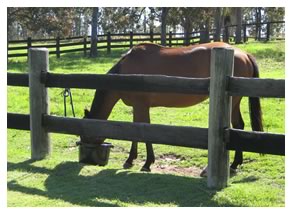
Home › Spinal Problems in Horses
Back and neck problems are common amongst horses just like ourselves. They can be recognised from a whole range of symptoms from obvious soreness when being saddled up or when being brushed along the back, through to having a poor appetite or diarrhoea.
Spinal problems have usually been developing for a long period by the time such symptoms are obvious. Back problems may become suddenly noticeable after a fall or other accident that further upsets the damaged areas of the spine, or after major trauma.
How does it occur? There’s a saying – “the bigger you are the harder you fall”. It’s true for horses too. Every day horses injure part of their spine. Just tripping in the paddock or getting cast in the stall is enough to do it. It’s a normal thing.
Damage can occur through falls, ill fitting tack, bad posture or stress from sore or unbalanced lower limbs or bad rider posture. Most of the time the damage is minor and heals quickly. Damage causes the brain to restrict the movement of the vertebrae by tightening up the muscles around the vertebrae while the joints heal.
Usually, as the damage heals, all is freed up. Sometimes, it results in part of the spine staying in a restricted state until some trigger alerts the brain that this is wrong. Sometimes that trigger never occurs. A little damage on a regular basis, such as that caused by tight and tender back muscles caused by an ill fitting saddle, can be more damaging than a major fall. It can make the spine very susceptible to damage if the horse has even the most gentle fall.
Either way, back pain and spinal arthritis can easily develop. Preliminary studies indicate that a high proportion of racehorses are likely to have some minor spinal arthritis by two years of age.
Spinal problems involve the brain! Underlying spinal problems there is disturbance of the function of the nervous system, the caretaker of the body.
You can think of what is happening in this way. The brain is like one enormous computer, with more power than 100 pentium PCs. Every micro-second it has to read messages from billions of gauges scattered throughout the muscles and joints of the body, and every micro-second it has to fine tune the tension in each muscle.
It is no accident that we can bend our elbow to lift a drink without spilling it, and that a horse can hold its body in a beautiful frame whilst doing piaffe. Without the fine-tuning that the brain does each micro-second we’d have to use a baby’s drinking cup and the horse would be falling on its rear.
Correct control of each muscle is dependent on the brain getting clear signals to and from the muscle. Increased tension in a small spinal muscle, which has been holding the spinal joints in a protected manner long after the spinal injury has healed, tightness of muscles along the spine, eg from saddle soreness, and swelling of the spinal joints from arthritis, are all influences which can tighten the gap between vertebrae where the spinal nerves exit and puts pressure on the spinal nerves which feed into the body and limbs.
The pressure distorts the signals to and from the muscle, turning up the “volume” and resulting in increased muscle tightness and tenderness in the corresponding muscles, eg tight and tender hamstrings with lower back problems.
